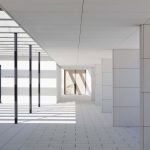Institución Benéfico Social Padre Rubinos (A Coruña, España) por Elsa Urquijo Architects. La Institución Benéfico Social Padre Rubinos nace en A Coruña hace casi un siglo con vocación de dar cobijo y asilo al necesitado. Posteriormente ha ido creciendo y ampliando su ámbito de actuación a Escuela Infantil y Residencia de Ancianos.
Su nueva sede que nace de una forma silenciosa de entender la arquitectura. La edificación se concibe como una cobertura para la vida que transcurre en ella, un espacio sereno, íntegro y con voluntad de permanencia.
El uso de la linea horizontal surge como consecuencia de esa búsqueda de sosiego y relajación configurando una sucesión de espacios mensurables y ordenados.
Se trata de un espacio arquitectónico que gira entorno al individuo renunciando a la composición académica de fachada y ofreciendo un pórtico de entrada que rodea y define una plaza abierta a la ciudad.
Retomamos el concepto de claustro en sintonía con el carácter religioso y la labor social de la institución.
La idea de patio se repite en todo el complejo como elemento articulador de los diferentes espacios buscando potenciar la diafanidad, la luz y la continuidad visual entre interior y exterior.
Ficha tecnica
Nombre: Institución Benéfico Social Padre Rubinos
Ubicación: A Coruña, España
Proyectista: Elsa Urquijo Architects
Comitente: Fundación Amancio Ortega
Jefe de proyecto: Elsa Urquijo
Colaboradores: Gema Rivas, María Freixedo, Iria Senra, Nieves González, Carla Galante, Ignacio Urquijo, Xavier Loureiro, Ruth Mascato
Ingeniería: Instra Ingenieros
Constructor: GOA Invest
Fecha finalizacion de proyecto: 2014
Superficie: 15882 m2
Fotografía: Elsa Urquijo Architects
Contacto: http://www.elsaurquijo.com
English version
The social charity institution Padre Rubinos was born in A Coruña nearly a century ago with a dedication to give shelter and asylum to the needy. Later it has continued growing and expanding its scope to nursery schools and the elderly. Now, Spanish architect Elsa Urquijo presents their new headquarter to us. This is one of the most important in the country in its field because it unifies a wide range of services (shelter, nursery, nursing home, etc.) in a unique architectural complex.
The design has born in a quite way of understanding architecture. The building is conceived as a shelter for the life that transcends in it, a serene space, unpretentious and to endure. The use of horizontal lines arises from the search for peace and relaxation creating a sequence of measured and ordered spaces.
It is an architectural space that revolves around those individuals in need, the academic composition of the facade and featuring a portico at the entrance that surrounds and defines a square, open to the city. They re-assume the concept of cloister attuned to the religious character and social work of the institution.
The idea of a patio is repeated throughout the architectural complex as focal point of the different spaces seeking to strengthen the clarity, light and visual continuity between interior and exterior. Different volumes fit the morphology of the terrain so that both ground floor and the upper floors maintain direct external communication.
The nursing home for the elderly occupies the most extensive use of the complex. At the ground floor are the common areas like living rooms, professional offices, therapy rooms, etc. while at the upper two floors private areas are located linked to the bedrooms.
Special care has been taken in the use of materials that meet the requirements for a building of these characteristics: high quality, strength, durability, ecology (we use a kind of floor which catalyze the carbon dioxide as leafs in the forest do). Meanwhile giving humanity, serenity and warmth to the interior (warm soil, wood texture, natural fabrics, etc.)
The nursery school is set on a single floor. The clarity and spatial continuity between the classrooms allow for a versatile use of the same. A visual and symbolic relationship to the common areas of the nursing home is also sought after so that both generations can relate and bond.
The homeless shelter is divided into 3 different uses: accommodation, dining and a center of ongoing social care to be carried out mainly on the ground floor and the upper floor reserved for the rooms. The access to the homeless shelter goes back to the concept of an open space whose portico gives a human scale and protects the visitor.
Besides these basic uses, the complex also includes a residence for the sisters. They manage the homeless shelter, headquarters for the institution and area representative with an assembly hall and a chapel which is a symbol and an attraction within the complex.
Their presence is evidenced by clearly recognizable elements as the bell tower and the entrance with orderly and serene architecture.
The entrance is through a secluded and warm space arriving to a magnified space which enhances the symbolism of the place. This in turn embraces us by the horizontal line of the wooden plinth which returns it to a human scale.
About Elsa Urquijo Architects
Elsa Urquijo Architects is an architecture and interior design office based in A Coruña since 2000. They understand architecture as a continuous quest for simplicity and clarity of the idea and the rigor of the application of their conception in the built work. They are interested in developing an architecture that stimulates the senses beyond sight, through the materiality and scale.
Fact Sheet
Name: The social charity institution Padre Rubinos headquarters
Location: A Coruña, Spain
Client: Fundación Amancio Ortega
Architects: Elsa Urquijo Architects
Project Manager: Elsa Urquijo
Collaborators: Gema Rivas, María Freixedo, Iria Senra, Nieves González, Carla Galante, Ignacio Urquijo, Xavier Loureiro, Ruth Mascato
Engineers: Instra Ingenieros
Contractors: GOA Invest
Area of project: Healthcare
Project end date: 2014
Area: 15.882 m2
Photos: Elsa Urquijo Architects
Via V2com



















